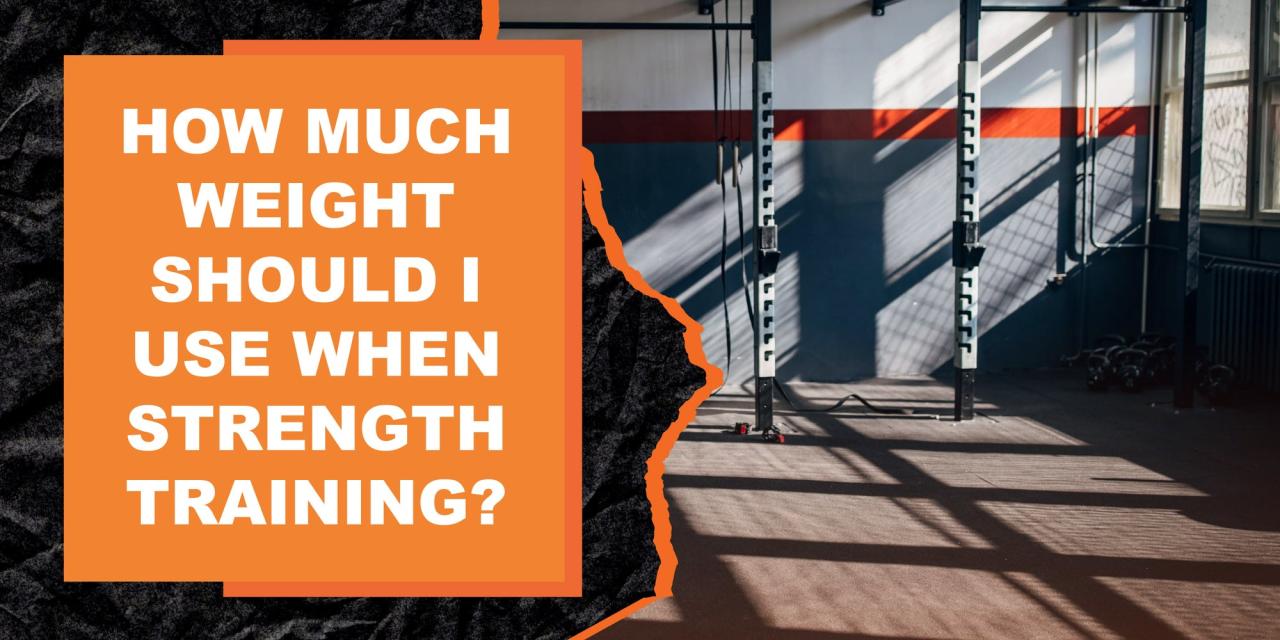What weights should I lift for strength training and weight loss? Ah, the million-dollar question that plagues even the most seasoned gym-goers (and those who’ve only ever lifted a spoon!). Forget the confusing charts and overly-technical jargon – let’s unravel this mystery with a healthy dose of humor and practical advice. We’ll navigate the world of reps, sets, and progressive overload, all while ensuring you don’t accidentally launch yourself across the room with a rogue dumbbell.
Get ready to sculpt your physique and maybe even impress a few onlookers (or at least your cat).
This guide will cover everything from choosing the right weight for beginners to mastering progressive overload and understanding the crucial role of rest and recovery. We’ll explore different rep ranges and their impact on your goals, and we’ll even touch on the importance of a balanced diet – because let’s face it, abs are made in the kitchen (and the gym, obviously!).
We’ll debunk common myths, offer practical tips, and leave you feeling empowered to conquer your fitness journey. Ready to lift off?
Understanding Strength Training Principles for Weight Loss
So, you want to sculpt a physique worthy of a Greek god (or goddess!) while shedding those extra pounds? Fantastic! Strength training isn’t just about bulging biceps; it’s a powerful tool for weight loss, and we’re about to unlock its secrets. Forget endless cardio – let’s build some serious muscle and metabolic fire.Strength training, muscle growth, and metabolism are a dynamic trio working in beautiful harmony (or at least, they will be once you understand how).
Building muscle increases your resting metabolic rate (RMR). Think of your RMR as your body’s internal furnace – the more muscle you have, the hotter that furnace burns, even when you’re chilling on the couch watching cat videos. This means you burn more calories throughout the day, even without exercising. It’s like having a personal, muscle-powered calorie-torching machine!
Types of Strength Training Exercises
Choosing the right exercises is crucial for maximizing results. We’ll delve into the world of compound and isolation exercises. Compound exercises, the powerhouses of strength training, work multiple muscle groups simultaneously. Think squats, deadlifts, bench presses – movements that engage your entire body. These are your calorie-crushing champions! Isolation exercises, on the other hand, target specific muscle groups.
Bicep curls, tricep extensions – these hone in on individual muscles for refined shaping. They’re the detail artists of your fitness masterpiece. A balanced approach incorporating both is key for overall strength and physique development.
Sample Workout Routine
Now for the fun part: a sample workout routine. Remember, this is a suggestion; adjust it based on your fitness level and experience. Always consult a healthcare professional before starting any new workout routine.
| Exercise | Sets | Reps | Rest Time (seconds) |
|---|---|---|---|
| Squats (Compound) | 3 | 8-12 | 60 |
| Bench Press (Compound) | 3 | 8-12 | 60 |
| Deadlifts (Compound) | 1 | 5 | 120 |
| Bent-Over Rows (Compound) | 3 | 8-12 | 60 |
| Bicep Curls (Isolation) | 3 | 10-15 | 45 |
| Triceps Extensions (Isolation) | 3 | 10-15 | 45 |
Remember to focus on proper form over lifting excessively heavy weights, especially when starting. Listen to your body and don’t push yourself too hard, especially in the beginning. Consistency is key! Think of it like this: you wouldn’t expect to become a master chef after one cooking lesson, right? Building muscle and achieving your weight loss goals takes time and dedication.
Determining Appropriate Weight for Beginners
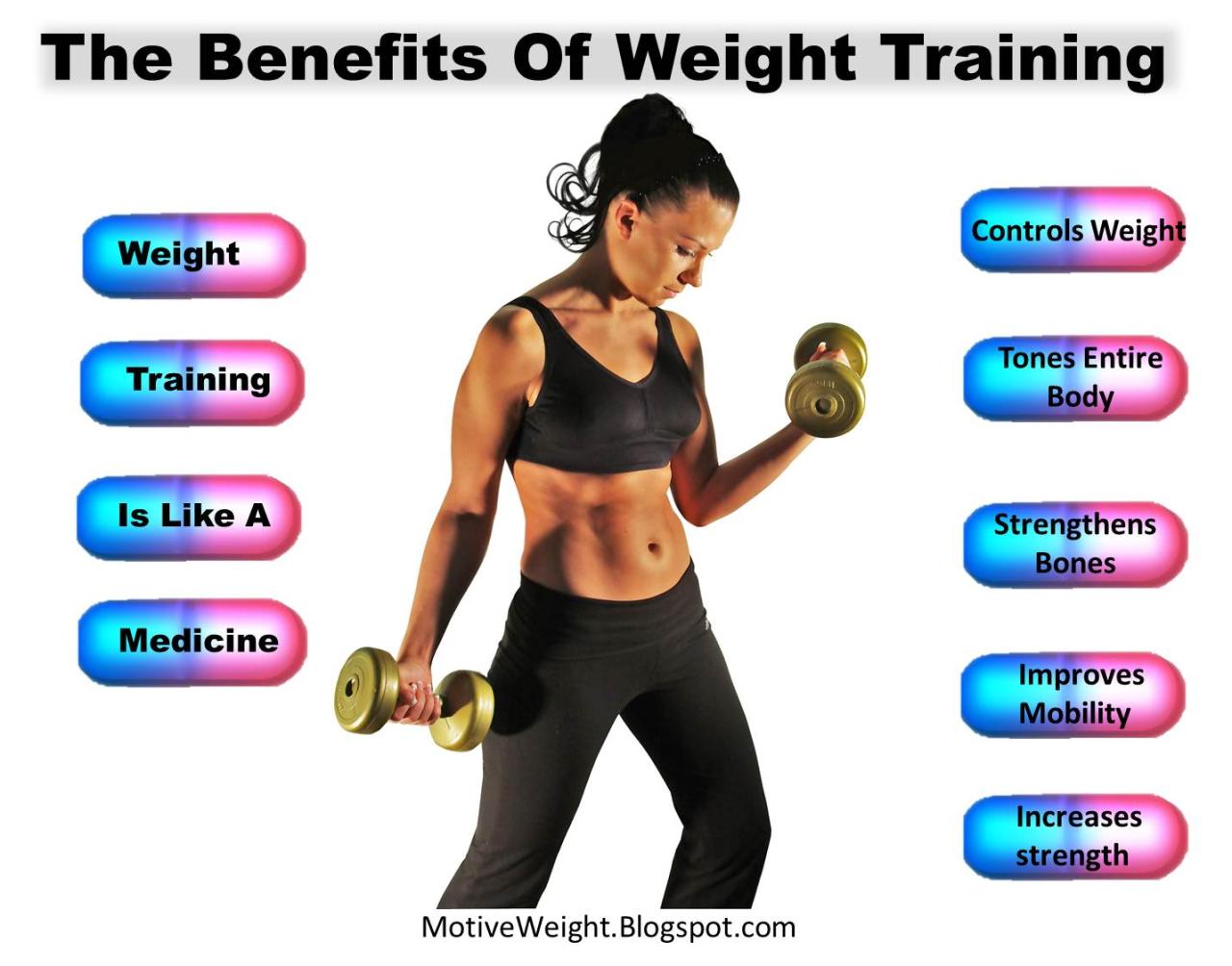
So, you’re ready to embark on your strength training journey? Fantastic! Forget those images of bulging biceps and grunting weightlifters – we’re focusing on building a solid foundation, not immediately breaking any personal bests (or bones!). This means starting light, focusing on perfect form, and gradually increasing the weight. Think of it as a marathon, not a sprint – consistency wins the race!Choosing the right weight for beginners is crucial.
It’s about finding that sweet spot where you can challenge your muscles without compromising your technique. Lifting too heavy too soon is a recipe for injury and frustration, leading to a quicker-than-expected abandonment of your fitness goals. Conversely, lifting weights that are too light won’t stimulate muscle growth or provide sufficient challenge.
A Beginner’s Strength Training Program
This program focuses on compound movements, which work multiple muscle groups simultaneously, maximizing efficiency and calorie burn. Remember, proper form is paramount. It’s better to lift a lighter weight with perfect form than a heavier weight with sloppy technique. If you’re unsure about the proper form, consider working with a qualified personal trainer for a few sessions to learn the correct techniques.
| Exercise | Sets | Reps | Rest (seconds) |
|---|---|---|---|
| Squats | 3 | 8-12 | 60 |
| Push-ups (on knees if needed) | 3 | As many as possible (AMRAP) | 45 |
| Rows (using resistance bands or dumbbells) | 3 | 8-12 | 60 |
| Lunges (alternating legs) | 3 | 8-12 per leg | 60 |
| Plank | 3 | 30-60 seconds | 45 |
Identifying the Right Weight
The “right” weight is subjective and depends on your individual strength level. A good starting point is choosing a weight that allows you to complete the prescribed number of repetitions with good form for all sets, while feeling challenged by the last two reps. If you can easily complete all reps with perfect form and feel you could do several more, increase the weight next time.
If you struggle to maintain good form, or experience pain, decrease the weight. Imagine lifting a weight that feels like a 7 or 8 out of 10 on the difficulty scale.
Gradually Increasing Weight
Think of your weight as a faithful companion, steadily increasing in weight alongside your strength. Once you can comfortably perform all sets and reps with good form for a particular weight, increase it by a small increment (e.g., 2.5 lbs or 1 kg for dumbbells, or a small plate on a barbell). Don’t jump up in weight too quickly; slow and steady wins the race! Consistency and gradual progression are key to building strength and avoiding injury.
Consider increasing the weight every 1-2 weeks, depending on your progress and how your body feels.
“Progress, not perfection.” This is your mantra for weight training.
Progressive Overload for Strength and Weight Loss
Think of your muscles like a mischievous puppy – you need to constantly challenge them to keep them growing stronger and leaner. Ignoring this crucial fact is like trying to teach a puppy to sit by whispering sweet nothings; it’s just not going to happen. Progressive overload is the key to unlocking your body’s full potential for both strength gains and fat loss.
It’s the systematic process of gradually increasing the demands placed on your muscles, forcing them to adapt and improve. Without it, your workouts become stale, your progress plateaus, and your motivation dives faster than a lead balloon.Progressive overload isn’t about suddenly adding 50 pounds to the bar and risking a herniated disc (though that might be hilarious to watch on YouTube, don’t try it!).
It’s a gradual, controlled increase in the intensity of your training over time. This allows your body to adapt safely and efficiently. Think of it as a slow and steady climb up a mountain, rather than a reckless sprint that ends in a spectacular fall.
Methods for Progressive Overload
There are several ways to progressively overload your muscles, and the beauty is that you can mix and match them to keep things interesting. Simply sticking to one method can lead to boredom (and boredom leads to Netflix binges and chocolate-covered pretzels).
- Increasing Weight: This is the most straightforward method. As you get stronger, you gradually increase the weight you lift for each exercise. This directly challenges your muscles to work harder. For example, if you’re bench pressing 100 pounds for 8 reps, you might increase it to 105 pounds next week.
- Increasing Repetitions: If you’re comfortably completing your sets, increase the number of repetitions you perform for each set. For instance, if you’re doing 8 reps, try for 10 next week. This increases the time under tension, which further stimulates muscle growth.
- Increasing Sets: Another way to increase the volume of your workout is to add an extra set to each exercise. If you’re currently doing 3 sets of squats, add a fourth set next week. Remember, your muscles are like sponges; they soak up the work, getting bigger and stronger in the process.
- Decreasing Rest Time: Reducing the rest periods between sets increases the metabolic demand on your body, making your workout more intense. This can be a powerful tool for both strength and fat loss. If you are resting for 60 seconds between sets, try reducing it to 45 seconds.
Sample 8-Week Progressive Overload Plan for Beginners
This plan focuses on compound exercises, which work multiple muscle groups simultaneously. Remember to consult your doctor before starting any new workout routine. This plan is a suggestion and should be adjusted to your individual needs and abilities. Don’t be afraid to modify it as you progress. We are aiming for controlled progression, not a race to the finish line (unless that finish line is a buffet, then sprint away!).
We’ll focus on three key exercises: Squats, Bench Press, and Rows. Start with a weight you can comfortably lift for 8-12 repetitions. Aim for 3 sets of each exercise.
- Week 1-2: Baseline weight.
- Week 3-4: Increase weight by 2.5-5 pounds (or 1-2 kg) per exercise.
- Week 5-6: Increase weight by another 2.5-5 pounds (or 1-2 kg) per exercise.
- Week 7-8: Increase weight by another 2.5-5 pounds (or 1-2 kg) per exercise, or add a fourth set if weight increase feels too challenging.
Important Note: If you cannot complete all the reps and sets with good form at a given weight, it’s time to decrease the weight and focus on proper technique. Remember, quality over quantity!
Weight Selection Based on Repetition Ranges: What Weights Should I Lift For Strength Training And Weight Loss
So, you’ve conquered the basics of strength training and are ready to delve into the slightly more…
intense* world of rep ranges. Think of it like this
So, you’re wondering about those magical weights for strength and slimming? The sweet spot depends on your goals, but generally, aim for a weight that challenges you without sacrificing form. For a deeper dive into building those glorious muscles, check out these comprehensive weight training programmes for muscle growth , which will help you figure out the perfect weight for your strength journey.
Remember, even tiny gains are victory laps in the weightlifting arena!
choosing the right weight isn’t just about lifting heavy; it’s about liftingsmartly* to achieve your specific goals. We’re talking about sculpting that physique, boosting strength, or maybe even both!Choosing the right weight is a crucial part of maximizing your results. Different rep ranges target different muscle fibers and lead to different adaptations in your body. It’s like having a secret code to unlock your fitness potential.
Let’s crack that code!
Rep Ranges and Their Effects on Strength and Hypertrophy
The number of repetitions you perform in a set directly influences the type of muscle adaptation you experience. Low reps (1-5) are all about building raw strength, like a mighty oak tree. Higher reps (12+) focus on muscle growth (hypertrophy), leading to a more sculpted, defined look. The middle ground (6-12 reps) offers a happy medium, building both strength and size.
It’s like finding the perfect balance between power and aesthetics.
So, you’re wondering about weights for strength training and weight loss? The short answer is: start light! Don’t go hulk-smashing right away. To build a solid foundation, check out this awesome beginner workout program for strength and muscle building to learn proper form. Once you’ve mastered that, you can gradually increase the weight, focusing on controlled movements and feeling the burn (in a good way, of course!).
Remember, consistency trumps crazy heavy weights.
Weight Selection Strategies Based on Rep Range and Goal
The weight you choose is intimately linked to your desired rep range and your overall goal. If your goal is to lift a small car, you’ll need to choose weights that challenge you in the 1-5 rep range. If your goal is to look like you could lift a small car, you’ll want to focus on higher reps with a weight that allows you to maintain good form.
It’s all about finding that sweet spot where you’re pushing your limits but not compromising your technique.
Weight Selection Table
This table summarizes the relationship between rep ranges, training goals, and weight selection strategies. Remember, these are guidelines, not strict rules. Always prioritize good form over lifting heavier weights.
| Rep Range | Training Goal | Weight Selection Strategy |
|---|---|---|
| 1-5 reps | Strength | Choose a weight that allows you to complete only 1-5 repetitions with perfect form. This weight should feel very heavy, representing approximately 85-100% of your 1-rep max (1RM). Think “heavy and slow.” |
| 6-12 reps | Strength and Hypertrophy | Select a weight that allows you to perform 6-12 repetitions with good form. This typically represents 65-85% of your 1RM. Think “challenging but manageable.” |
| 12+ reps | Hypertrophy | Choose a lighter weight, allowing you to perform 12 or more repetitions with good form. This usually falls within the 50-70% 1RM range. Think “muscle burn!” |
Incorporating Rest and Recovery
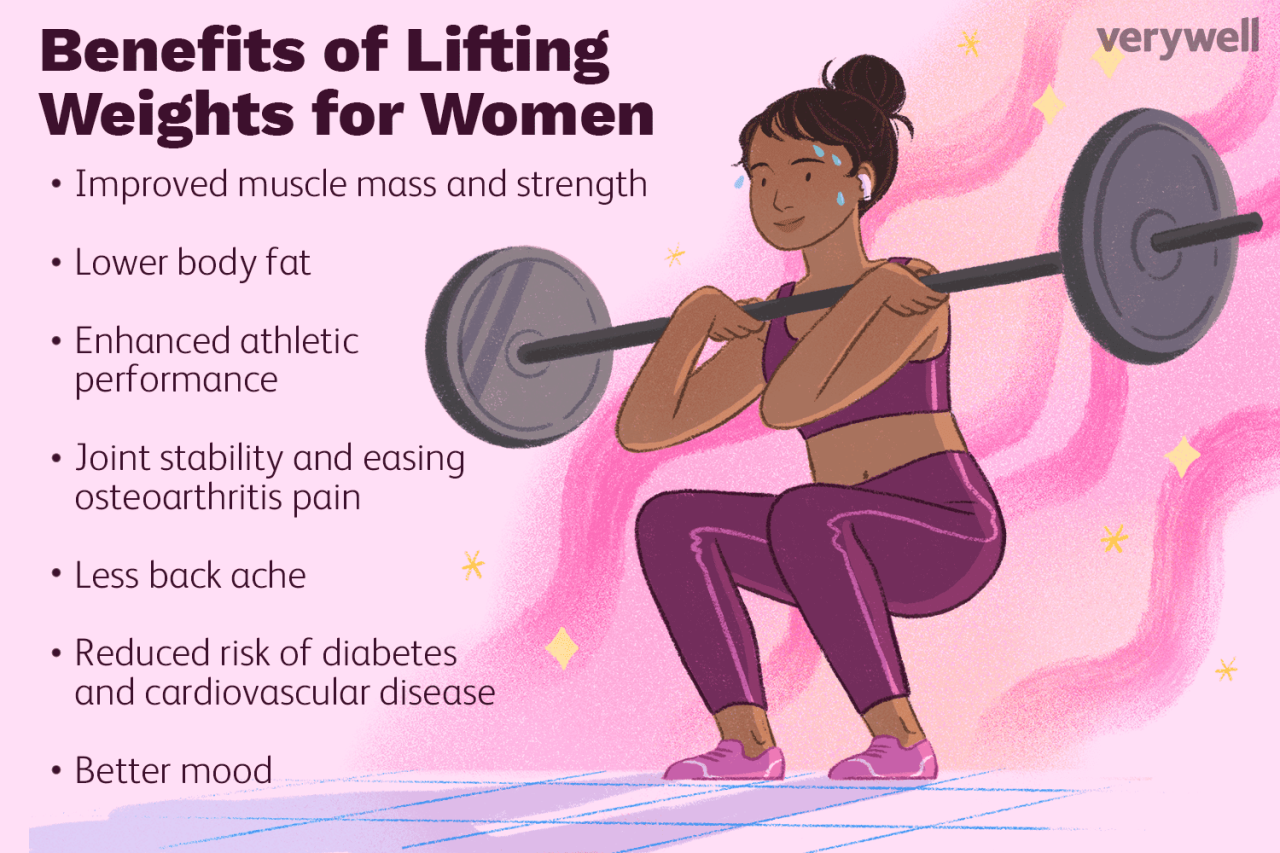
Think of your muscles like a delicious sourdough starter – you need to feed it (with workouts), but youalso* need to let it rest and rise to achieve its full potential. Ignoring rest is like punching a loaf of bread and expecting it to become a fluffy masterpiece. It just won’t happen. Rest and recovery are just as crucial to strength training and weight loss as the workouts themselves; they’re the unsung heroes of your fitness journey.
Without them, you risk injury, burnout, and stalled progress.Rest allows your muscles to repair and rebuild after the strenuous demands of your workouts. During rest, your body synthesizes protein, which is essential for muscle growth and repair. It also replenishes glycogen stores, your muscles’ primary fuel source. Insufficient rest leads to overtraining, characterized by fatigue, decreased performance, and increased susceptibility to injury – not exactly the recipe for a successful weight loss plan.
So, you’re wondering about the right weights for strength training and weight loss? It’s all about finding that sweet spot – challenging enough to build muscle, but not so heavy you’ll collapse in a heap. To figure out your perfect weight range, check out this awesome strength training program for weight loss and toning for guidance.
Remember, it’s a journey, not a race, so adjust your weights as you get stronger! Eventually, you’ll be lifting like a champion (or at least, like a very fit champion-in-training).
Creating a Balanced Training Schedule
A well-structured training schedule incorporates rest days strategically. A common approach is to follow a split routine, focusing on different muscle groups on different days. For example, you might train your upper body one day, your lower body the next, and then take a rest day. This allows each muscle group ample time to recover before being challenged again.
So, you’re wrestling with the age-old question: what weights should you lift? The answer, my friend, is a delightful dance between challenge and progress. To find that sweet spot, check out the best strength training program for a structured approach. This will help you determine the perfect weight to build muscle and torch those calories, ensuring you’re lifting smart, not just hard!
The frequency of your rest days will depend on your training intensity and individual recovery capacity. Listening to your body is key; if you’re consistently feeling excessively sore or fatigued, it’s a sign to schedule more rest. Don’t be a fitness martyr; your body will thank you for it.
Active Recovery Methods, What weights should I lift for strength training and weight loss
Active recovery doesn’t mean hitting the gym with the same intensity as your regular workouts. Instead, it involves light activities that promote blood flow and reduce muscle soreness without further stressing your muscles. Think of it as a gentle nudge, not a full-blown workout. Examples include a leisurely walk, swimming, cycling at a low intensity, or yoga. These activities improve circulation, helping to flush out metabolic waste products that accumulate in your muscles after intense training.
So, you’re wondering about the perfect weight for strength and slimming? Forget the heavy stuff initially – you’re not trying to become a competitive weightlifter overnight! Start light, focusing on good form. For a fantastic guide on building a solid base, check out this simple and effective weight lifting routine for beginners – it’ll help you nail the technique before you crank up the kilos.
Then, gradually increase the weight as you get stronger. Remember, consistency trumps intensity in the beginning!
They also help maintain flexibility and prevent stiffness, which is particularly important after weight training. A light 20-30 minute walk after a tough leg day can feel remarkably refreshing and aid in the recovery process. Imagine it as giving your muscles a spa day, but instead of cucumber slices, they get a gentle flow of blood and oxygen.
Listening to Your Body and Adjusting Weight
Ignoring your body’s whispers (and sometimes screams) during strength training is a recipe for disaster – think grumpy muscles, nagging injuries, and a stalled fitness journey. Learning to listen to your body and adjust your weights accordingly is crucial, not just for avoiding injury, but for maximizing your results. It’s about finding that sweet spot between pushing your limits and preventing a workout wipeout.Your body is a pretty sophisticated piece of equipment, and it’s constantly sending you signals.
The trick is learning to decipher them. Ignoring these signals can lead to overtraining, a condition where your body is overworked and unable to recover adequately. This isn’t just about feeling tired; it’s about recognizing the subtle (and not-so-subtle) signs that something’s amiss.
So, you’re wondering about the perfect weight for sculpting your physique and shedding those extra pounds? The answer isn’t a magic number, but finding a weight that challenges you without causing injury is key. To discover tailored programs that’ll guide you through this, check out some awesome resources like those listed on top websites for strength training programs and plans which can help you figure out the best weight for your strength journey.
Remember, gradual progression is your friend – start light and work your way up!
Recognizing Signs of Overtraining and Adjusting Weight Accordingly
Overtraining manifests in various ways. You might experience persistent muscle soreness that doesn’t improve with rest, increased fatigue, decreased performance, difficulty sleeping, or even changes in mood. Imagine trying to run a marathon on three hours of sleep and a diet of stale crackers – not ideal. If you notice these signs, it’s time to back off. Reduce the weight you’re lifting, shorten your workout duration, or take a complete rest day.
Think of it as giving your body a well-deserved vacation. Don’t be a workout warrior; be a smart one. A lighter weight, performed with perfect form, is far more beneficial than a heavier weight performed sloppily, leading to potential injury.
Preventing Injuries by Prioritizing Proper Form and Listening to Your Body
Proper form is paramount. Lifting heavy weights with poor form is like trying to build a house with crooked bricks – it’s unstable and likely to collapse. Focus on controlled movements, maintaining a neutral spine, and engaging the correct muscle groups. If you find yourself struggling to maintain proper form, reduce the weight immediately. Think of it like this: perfect form with a lighter weight is far superior to flawed form with a heavier weight.
Listen to your body. If a particular exercise causes sharp pain, stop immediately. Don’t push through pain; that’s a surefire path to injury. Modify the exercise or skip it altogether. Remember, a missed workout is better than a missed year of training due to injury.
Adjusting Weights Based on Individual Progress and Energy Levels
Your fitness journey isn’t a straight line; it’s more like a rollercoaster with ups and downs. Some days you’ll feel like a superhero, crushing your workouts with ease. Other days, you’ll feel more like a slug. That’s perfectly normal. Adjust your weights accordingly.
On high-energy days, you might be able to push yourself a bit harder. On low-energy days, it’s perfectly acceptable (and recommended!) to lighten the load. Don’t be afraid to adjust your weight based on your individual progress. If you’re consistently hitting your reps with good form, it’s time to increase the weight gradually. If you’re struggling, don’t hesitate to decrease it.
Remember, progress is not linear; consistency is key.
Nutrition and Weight Loss
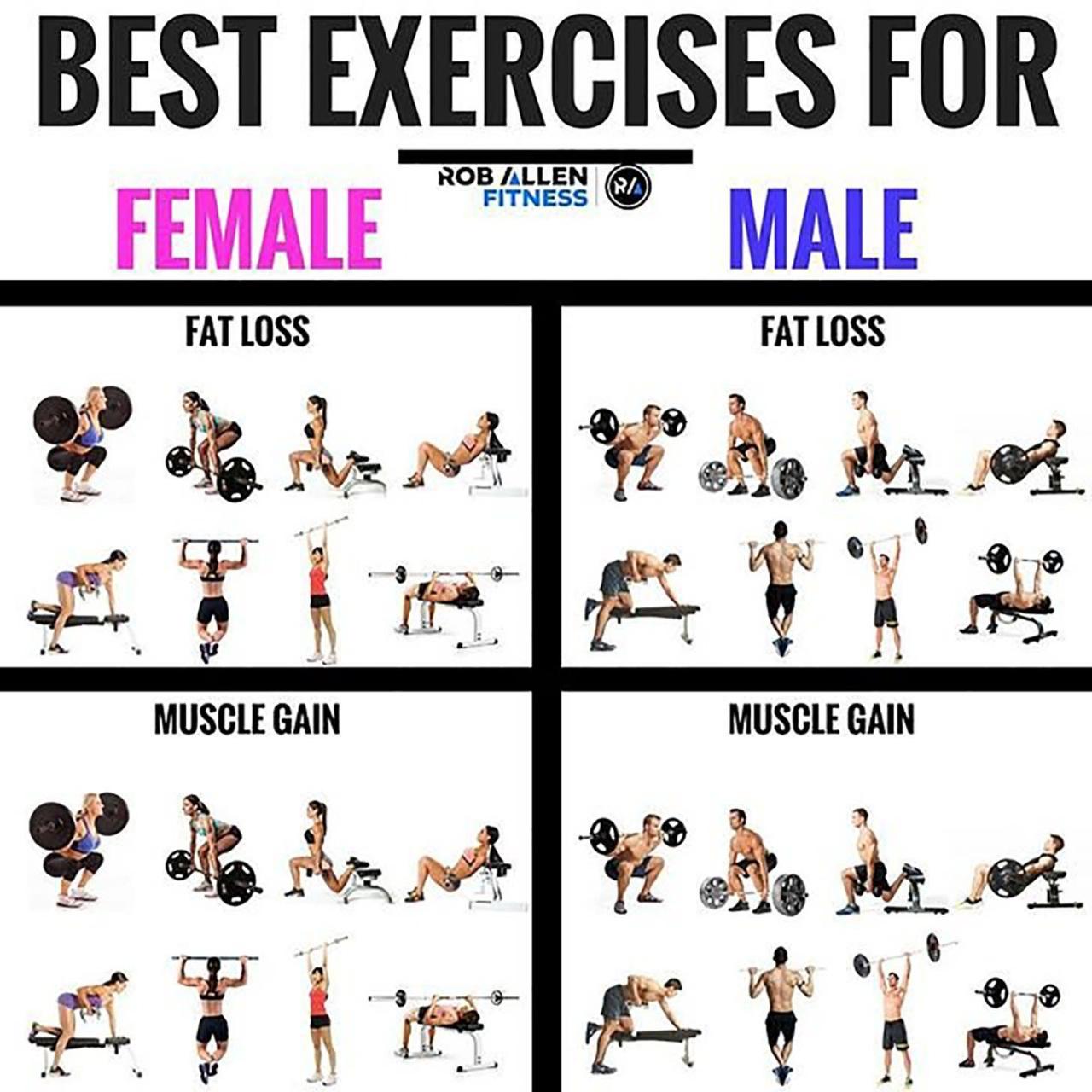
Let’s be honest, lifting weights is only half the battle. You can pump iron like a champion, but if your diet resembles a college student’s late-night pizza binge, your weight loss goals will be about as successful as a snowball in Hades. Nutrition plays a crucial role in both building muscle and shedding fat; it’s the fuel that powers your workouts and helps your body recover and rebuild.
Think of it as the other half of the superhero duo: you’ve got your strength training (the muscle), and nutrition is the brains, strategizing the whole operation.Proper nutrition supports strength training by providing the building blocks for muscle growth and repair. Sufficient protein is essential for muscle protein synthesis – that fancy term for building new muscle tissue. Carbohydrates provide the energy you need to power through those intense workouts, and healthy fats support hormone production and overall bodily functions.
Without adequate nutrition, your body simply won’t have the resources to adapt to the demands of strength training, leading to slower progress, increased fatigue, and a higher risk of injury. It’s like trying to build a skyscraper with toothpicks and glue – it’s not going to stand!
A Balanced Diet for Muscle Growth and Fat Loss
A balanced diet for both muscle growth and fat loss focuses on consuming enough protein to support muscle repair and growth, sufficient carbohydrates to fuel workouts, and healthy fats for hormone regulation and overall health. It’s not about starvation; it’s about making smart food choices that support your fitness goals. Think of it as a well-orchestrated symphony, where each nutrient plays its part to create a harmonious body composition.
We’re aiming for a lean, mean, muscle-building machine, not a wilting flower!
Visual Representation of a Balanced Meal Plate
Imagine a dinner plate divided into three sections. The largest section (about 40%) is filled with colorful vegetables – think broccoli, spinach, bell peppers, and carrots. These provide essential vitamins, minerals, and fiber, keeping you full and energized. The next largest section (about 30%) is dedicated to a lean protein source – grilled chicken breast, salmon, lentils, or tofu.
This section fuels muscle growth and repair. The smallest section (about 30%) contains a healthy fat source – a small amount of avocado, a handful of nuts, or a drizzle of olive oil. These fats support hormone production and overall health. This isn’t a rigid rule, but a visual guide to help you balance your meals. Remember, portion sizes are key – even healthy foods can contribute to weight gain if consumed in excess.
This is about creating a balanced meal, not a rigid formula. Flexibility is key!
Seeking Professional Guidance
Let’s face it: navigating the world of strength training and weight loss can feel like trying to assemble IKEA furniture while blindfolded. It’s a maze of confusing information, conflicting advice, and the ever-present risk of injury. That’s where the superheroes of fitness and nutrition come in: certified personal trainers and registered dietitians. They’re your secret weapons in this battle against flab and fatigue.Investing in professional guidance isn’t just about faster results; it’s about preventing setbacks and ensuring you’re doing things correctly and safely.
A qualified professional can provide personalized support, tailored to your specific needs, goals, and, most importantly, your body’s quirks. Think of them as your personal fitness and nutrition Sherpas, guiding you up the mountain of weight loss and strength gain without you tumbling down the wrong side.
Benefits of Professional Guidance
A certified personal trainer can be invaluable in correcting your form, ensuring you’re maximizing results while minimizing the risk of injury. They’ll teach you the proper techniques for each exercise, preventing those embarrassing (and potentially painful) wobbles and ensuring you’re targeting the right muscle groups. Imagine trying to learn a complex dance routine from a YouTube video versus having a professional choreographer guide you – the difference is night and day.
Similarly, a registered dietitian can help you design a nutrition plan that complements your strength training, ensuring you’re fueling your body effectively for optimal results. They’ll help you understand portion control, macronutrient balance, and the importance of hydration – all crucial components of successful weight loss.
Weight Selection and Program Design
A personal trainer can help you select the appropriate weights for your fitness level and goals. They will guide you through progressive overload, ensuring that you are continually challenging yourself without risking injury. This might involve starting with lighter weights to master the correct form, gradually increasing the weight as your strength improves. For example, if you’re starting with a dumbbell bench press, they’ll ensure you don’t jump straight to 20kg dumbbells if you can barely manage 5kg.
Instead, they’ll guide you through a structured program, steadily increasing the weight as you gain strength and confidence. This personalized approach minimizes the risk of injury and maximizes your progress.
Nutritional Guidance and Support
Registered dietitians offer a wealth of knowledge on creating a balanced diet that supports your fitness goals. They can help you create a meal plan that’s not just effective but also enjoyable and sustainable. They’ll help you understand the importance of adequate protein intake for muscle growth and repair, as well as the role of carbohydrates and healthy fats in providing sustained energy.
They might even help you debunk some common diet myths and develop healthy eating habits that you can maintain long-term. This isn’t about restrictive diets; it’s about making informed choices that fuel your body and help you achieve your goals.
Questions to Ask a Professional
Before embarking on a strength training and weight loss journey with a professional, it’s essential to ask clarifying questions. This ensures you’re a good fit and understand their approach.A list of crucial questions includes:
- What is your experience and certification in strength training and weight loss?
- What is your approach to program design, and how will you personalize it to my needs and goals?
- What safety precautions do you emphasize, and how will you ensure I’m performing exercises correctly?
- How will you monitor my progress, and how often will we adjust the program?
- What is your philosophy on nutrition, and how will you integrate nutritional guidance into my training program?
- What is your fee structure, and what does it include?
Remember, choosing a professional is a significant investment in your health and well-being. Take the time to ask questions and find someone who understands your needs and aligns with your goals. It’s a partnership, not a dictatorship.
Last Point
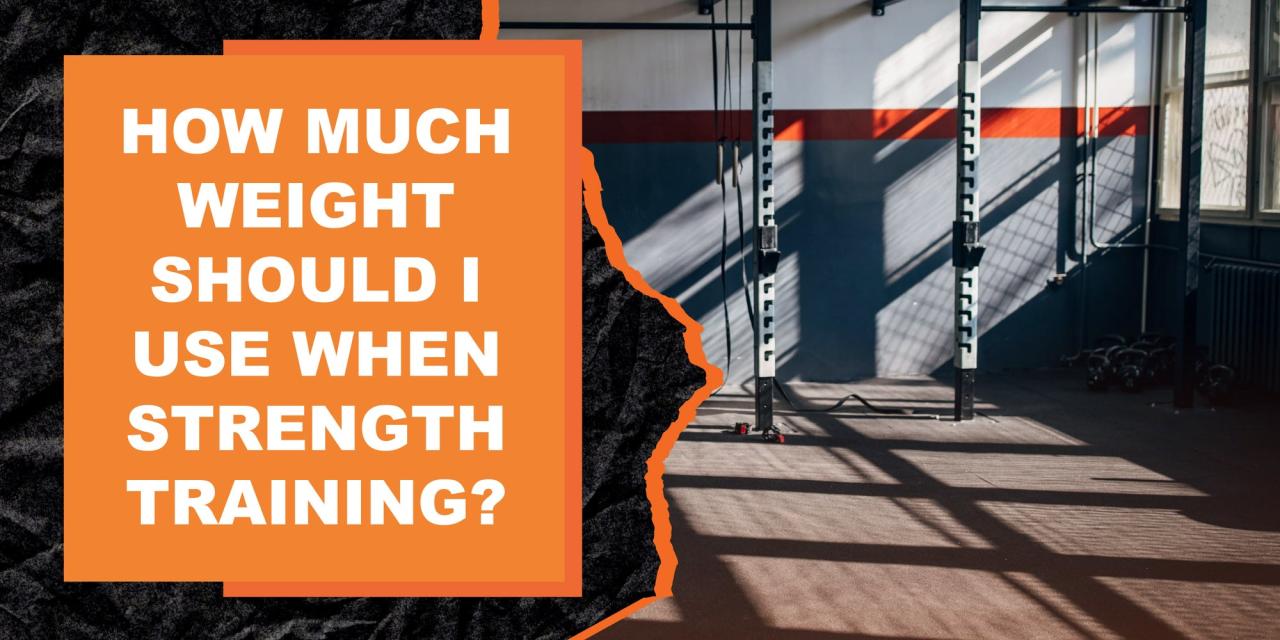
So, there you have it! Finding the right weight for strength training and weight loss isn’t rocket science (though it might feel like it sometimes). Remember, it’s a journey, not a race. Start light, focus on proper form, listen to your body, and gradually increase the weight as you get stronger. Don’t be afraid to experiment, and most importantly, have fun! Celebrate your progress, no matter how small, and remember that every rep brings you closer to your goals.
Now go forth and conquer those weights – and maybe even treat yourself to a well-deserved protein shake afterwards!
